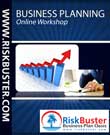 After reading an avalanche of articles on what a business plan should be, I’ve decided it might be helpful to write one about what a business plan should not be. The topic of business planning is sure to incite a lot of rhetoric and passion, whether or not you believe it to be a useful endeavor.
After reading an avalanche of articles on what a business plan should be, I’ve decided it might be helpful to write one about what a business plan should not be. The topic of business planning is sure to incite a lot of rhetoric and passion, whether or not you believe it to be a useful endeavor.
Even with all the hype there are misconceptions about what a business plan should or shouldn’t be. The poor old business plan is expected to do a lot for business owners. It’s little wonder that some people doubt the validity of the exercise. Here is what a business plan is not:
1. A Business Plan is Not a Tome. I’ve seen business plans ranging from a couple pages to over 200. Rarely should a business plan be more than 20 pages plus attachments; shorter is even better. If lifting the printed version of your business plan leads to a herniated disc in your lower lumbar region, or if it takes any more than 4 guys to carry it into your banker’s office, you’re probably overachieving. Wordy tomes are never read. The people who have to read the plans and make decisions are usually very busy. They will appreciate your efforts to keep the plan clear, simple and succinct.
2. A Business Plan is Not a Business. Delusional folks tend to believe that writing a big fat business plan will get them customers and sell products. Only the greenest of newbies could think the work is done once the plan is written and printed. That’s when the real work begins.
3. A Business Plan is Not a Guarantee of Success. A beautifully fashioned business plan is no assurance of business success whatsoever. No matter how cleverly crafted the narrative is, or how gorgeous the graphs are, or how dazzling the charts; nor does it make a difference how mouth-watering the financial projections are.
4. A Business Plan is Not a Substitute for a Bad Business Model. If you’re business model can’t deliver the goods to customers in a cost-effective, timely way, the business can’t succeed. No amount of business planning will compensate for a faulty business model.
5. A Business Plan is Not a Substitute for Street Smarts. Great business owners think on their feet. A business plan is a plan, not to be confused with the actions that fill a business owner’s day. Planning done right should result in setting strategy and avoiding some of the obvious traps along the way, but it won’t protect idiots from the impact of bad decisions in day to day operations. Your business plan will not protect you from bad business practices or pathetic personal conduct.
6. A Business Plan is Not a Complex, Time Sucking Activity. If you can’t blaze your way through a business plan in 2 to 4 weeks, you’re probably drilling too deep. In fact, many business plans can be blasted together much more quickly. Of course, the amount of time needed will vary according to the size and scope of the business, the type of business, the owner’s availability to work on the plan, how long it takes to build and test a prototype, and a whole lot of other factors. If your business plan eats up more than a couple months of your life, you’re probably getting way too deep, worrying too much, and procrastinating. Get it done and get yourself in front of customers.
7. A Business Plan is Not a Fix for Abysmal Personal Conduct. Planning won’t compensate for bad judgment. Forecasting is a powerful planning tool that can reveal whether or not your business has a chance of surviving or being profitable. No forecast can counteract the devastation that occurs when the owner continually removes too much money.
8. A Business Plan is Not Just for Owners Who Need Money.
A business plan can open the door to a loan or help attract an investor, but by far the biggest benefit of business planning is the knowledge an owner will gain from the researching and planning. The least understood benefit of business planning is the liberating and illuminating effects of writing about your business. You can’t help but strengthen your understanding and resolve when you dispel your assumptions; write your business description; write your vision, strategy, and goals; and remove the mystique from your revenues and expenses. The power of writing has more to offer the business owner than simply attracting a loan or investor.
9. A Business Plan is Not Etched in Stone. You’ll base your plan on a number of assumptions and you’ll build in buffers and safety factors. Your business plan will help you set parameters, but it won’t enable you to pin-point a precise path to success. In fact, many elements of your business plan will change the second you step into business. A business plan is a roadmap to your envisioned success. A map will not get you to a target; it’s the actions you take and the adjustments you make along the way that get you from your starting point to your cherished destination.
A business plan is just a plan. It’s not to be feared or revered. It certainly shouldn’t be put on a pedestal or parked on a shelf and ignored. A business plan is a living document that should be reviewed and revised as the business weaves and bobs its way through the marketplace. A business plan, providing you do it yourself, is the least expensive, most powerful tool available for taking control of your business and your financial future.

 Businesses with just one revenue stream, sometimes called one-legged ponies, tend to drop off the radar when the single revenue source dries up.
Businesses with just one revenue stream, sometimes called one-legged ponies, tend to drop off the radar when the single revenue source dries up. Working business models live and thrive all around us in the marketplace. In the world of business—manufacturers, wholesalers, distributors, retailers, and services—there are many tried and true business models. With the mass adoption of technology and the internet, old business models are morphing and new business models are emerging.
Working business models live and thrive all around us in the marketplace. In the world of business—manufacturers, wholesalers, distributors, retailers, and services—there are many tried and true business models. With the mass adoption of technology and the internet, old business models are morphing and new business models are emerging. Only Six days left to access your $100 Early-Bird Discount for the Business Planning Online Workshop!
Only Six days left to access your $100 Early-Bird Discount for the Business Planning Online Workshop!